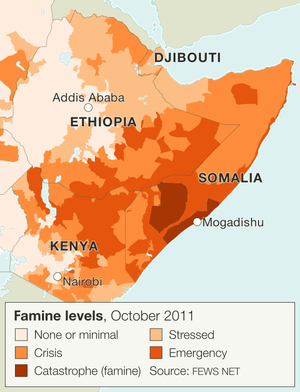What is famine?
Maps
How food shortages have come to be seen as a tragedy of the individual
Famine is an immediate and extreme scarcity of food, but it occurs only after a number of failures both short-term and long-term. In the short-term, famine is directly caused by some combination of natural disasters (drought, flooding), low levels of crop planting, high food prices, and the lack of individual access to food. In the long-term chronic poverty, inadequate development policies, and poor governance create a weakened system that is brought to collapse when suddenly affected by the short-term problems.
When does a crisis become a famine? It’s usually left to the government of the affected country to decide but a standard definition created by the United Nations and used by the the World Food Programme, the European Commission, Oxfam, and others, is the Integrated Food Security Phase Classification. When twenty per cent of the population has access to fewer than 2 100 calories of food a day, when there is acute malnutrition in more than thirty per cent of children, and when there are two deaths per 10 000 people every day (or four child deaths per 10 000 children), a crisis becomes a famine.

Figure 1: famine levels across east Africa in October 2011. Data source: FEWS NET.
In the 1960s and 1970s the approach to famine was to plant more crops and, if a harvest failed, for rich countries to send food aid. That strategy was found lacking in 1984 when catastrophic famine hit Ethiopia, a country that had food available — re-enforcing Amartya Sen’s argument in his 1981 book, Poverty and Famines, that what matters is not the overall supply of food but individual access. This is still true: figure 1 shows that in 2011 while some Ethiopians faced an emergency others had little or no food supply problems.
It’s evident that this is the case not just within a single country but on a global scale. In 1996 the Food and Agriculture Organization estimated that year’s food production provided enough for 2 700 calories for each person every day. The overall supply of food is adequate but not accessible on both a large and small scale.
Further reading
- Fighting famine in Southern Africa: steps out of the crisis, International Food Policy Research Institute, 2002
- Who, what, why: what is a famine?, BBC, 2011
- The nutrition puzzle, The Economist, 2012
- Poverty and Famines: an Essay on Entitlement and Deprivation, Amartya Sen, Clarendon Press, Oxford, 1981
References
- Food for all, World Food Summit, November 1996, Food and Agriculture Organisation of the United Nations